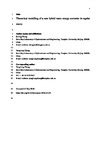Theoretical modelling of a new hybrid wave energy converter in regular waves
| dc.contributor.author | Zheng, Siming | |
| dc.contributor.author | Zhang, Y | |
| dc.date.accessioned | 2018-08-12T10:34:58Z | |
| dc.date.issued | 2018-12 | |
| dc.identifier.issn | 0960-1481 | |
| dc.identifier.issn | 1879-0682 | |
| dc.identifier.uri | http://hdl.handle.net/10026.1/12009 | |
| dc.description | publisher: Elsevier articletitle: Theoretical modelling of a new hybrid wave energy converter in regular waves journaltitle: Renewable Energy articlelink: https://doi.org/10.1016/j.renene.2018.05.051 content_type: article copyright: © 2018 Elsevier Ltd. All rights reserved. | |
| dc.description.abstract |
A novel hybrid wave energy converter (WEC) consisting of a floating oscillating water column (OWC) and several oscillating floats hinged around is proposed. Both water oscillation of the OWC and the wave-induced relative rotation of each float around the OWC are employed to extract wave power. To carry out the hydrodynamic analysis of the hybrid WEC, a theoretical model based on potential flow theory, separation of variables method and eigen-function matching method is presented. Hydrodynamic interaction between the OWC and the floats oscillating independently in surge, sway, heave, roll, pitch and yaw modes is considered. To verify the correctness of the theoretical hydrodynamic model, a specific example is computed and a numerical code based on a boundary element method is also employed as a comparison. The theoretical results are found in good agreement with ones obtained by using different approaches. The theoretical hydrodynamic model is then adopted to evaluate the dynamic response and power absorption of the hybrid WEC in frequency domain. Additionally, the corresponding isolated OWC and hinged floats are computed, respectively, and compared to demonstrate how to interact beneficially between the OWC and the floats in terms of q-factor. Effect of the geometry of both the OWC and the floats, and the spacing distance between them on power exploration of the hybrid WEC is investigated. The results reveal that the hybrid WEC holds a wider bandwidth of frequency response with a higher maximum power capture factor compared with those of the isolated OWC and hinged floats. | |
| dc.format.extent | 125-141 | |
| dc.language | en | |
| dc.language.iso | en | |
| dc.publisher | Elsevier | |
| dc.subject | Wave power | |
| dc.subject | Theoretical hydrodynamic model | |
| dc.subject | Oscillating water column | |
| dc.subject | Floats | |
| dc.subject | Power take-off system | |
| dc.title | Theoretical modelling of a new hybrid wave energy converter in regular waves | |
| dc.type | journal-article | |
| dc.type | Journal Article | |
| plymouth.author-url | https://www.webofscience.com/api/gateway?GWVersion=2&SrcApp=PARTNER_APP&SrcAuth=LinksAMR&KeyUT=WOS:000437079600011&DestLinkType=FullRecord&DestApp=ALL_WOS&UsrCustomerID=11bb513d99f797142bcfeffcc58ea008 | |
| plymouth.volume | 128 | |
| plymouth.publication-status | Published | |
| plymouth.journal | Renewable Energy | |
| dc.identifier.doi | 10.1016/j.renene.2018.05.051 | |
| plymouth.organisational-group | /Plymouth | |
| plymouth.organisational-group | /Plymouth/Faculty of Science and Engineering | |
| plymouth.organisational-group | /Plymouth/Faculty of Science and Engineering/School of Engineering, Computing and Mathematics | |
| plymouth.organisational-group | /Plymouth/REF 2021 Researchers by UoA | |
| plymouth.organisational-group | /Plymouth/REF 2021 Researchers by UoA/UoA12 Engineering | |
| plymouth.organisational-group | /Plymouth/Users by role | |
| plymouth.organisational-group | /Plymouth/Users by role/Academics | |
| dcterms.dateAccepted | 2018-05-15 | |
| dc.rights.embargodate | 2019-5-16 | |
| dc.identifier.eissn | 1879-0682 | |
| dc.rights.embargoperiod | Not known | |
| rioxxterms.versionofrecord | 10.1016/j.renene.2018.05.051 | |
| rioxxterms.licenseref.uri | http://www.rioxx.net/licenses/all-rights-reserved | |
| rioxxterms.licenseref.startdate | 2018-12 | |
| rioxxterms.type | Journal Article/Review |


